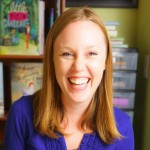Naomi Kinsman weaves her life around the creative process. Not only plumbing the depths of creativity for her middle-grade novels, but in teaching children and adults to find their passion for their stories. She started the Society of Young Inklings about eight years ago—named for C.S. Lewis’ and J. R. R. Tolkien’s Inklings group—to help children find their voices as writers. Naomi and I are represented by the same literary agency, and our paths frequently cross in the writing world. Her devotion to her craft is both inspirational and instructive. I spoke to Naomi by telephone to find out more about her creative process.
Patricia Newman: Is there a childhood memory that sticks out in your mind?
Naomi Kinsman: I was a very, very shy child. When I was in second grade, my mom took me to see a production of Annie, and I saw this little girl up on stage and she was exuberant and boisterous and I wanted that opportunity to try on a different personality. Around the same time our school was doing a musical called “Totally Buggy.” There was this character, a ladybug, who had this beautiful jazzy solo. I had my heart set on being the ladybug, but I couldn’t bring myself to audition. I admitted to my friend that I wanted the part. She got me to sing while we were alone on the swings. “The wind will be so loud I won’t be able to hear you,” she said. We did that day after day, and we got louder and louder. One day in class the girl who was the ladybug was sick, and the teacher asked for volunteers. Somehow I raised my hand. Everyone looked at me. No one thought I would do it, but I sang. I remember hearing my own voice in my ears, having my class look at me, and saying to myself you can do the impossible thing.
Newman: Do those same hopes and dreams from childhood appear in your stories today?
Kinsman: One theme I see running through everything that I write is how creativity helps us see the world at a deeper level. In the first Sadie book [Shades of Truth], Sadie learns to draw and to really see the world around her, and through that she asks questions about right and wrong and what she believes. Doing something so joyful—singing, acting, writing, drawing—is an expression of how we see the world, putting our thoughts and opinions out there. When you’re able to express your feelings and put them into a shape and form that someone can see, you have the potential to help change them or change a problem in your community. There are all sorts of possibilities!
Newman: Do you have a source of inspiration?
Kinsman: I think my biggest source of inspiration is other media. This week even though my next book’s deadline was looming, I took this mixed media art class where we did a project using different tools to build up the paint layer by layer by layer. It was so soothing to me because I was in the middle of this process feeling like my book hadn’t fully come into its own yet and I was a week away from my deadline. The process of layering [the paint] helped me see that art happens in layers. It’s okay if you can’t see it, or if it hasn’t quite gotten there yet because it needs a couple more layers. Many things like that come to me because I go off and play the guitar or work on a show or sing—I do something different which helps me return to my writing with fresh eyes.
Newman: How have ideas led to complete books?
Kinsman: For me it’s a little like a stewpot filled with ingredients that simmer together before I have a book. I often start with too few ideas, so I have to throw more in. For the first Sadie book I had the idea of a girl drawing to explore her world, and her dad would be involved in some sort of mediation in the community involving wild bears that she would watch him handle. The book, set outside of Yellowstone National Park, wasn’t fully gelling for me. At this time my husband and I spent a long weekend with a black bear researcher studying bear behavior in the forest. The researcher told stories about bears and his own community, and I was able to layer in that last piece of the story which grew out of the emotional reality of the researcher’s world. For me, I probably start a book before I have all of what I need, but I let what’s going on in my life inform it until I get to the point where it feels rich enough to be a book.
Newman: How does the Society of Young Inklings relate to your bigger picture as an author?
Kinsman: As I watched the business grow and evolve and become its own organization, I realized that my personal mission is about helping everyone be creative. I felt myself growing as a writer. In particular right now I’m very interested in how learning how to write and tell stories helps change how we see our own stories. For instance, if I can write a story with a character who makes choices and those choices affect the outcome of the story, then I start to realize how much power there is in those daily decisions as a writer. And I start to see it in my own life, too. I’ve seen it happen with children and other adults. I see a lot of power for transformation.


